Abstract
To investigate the role of IgE-bearing Langerhans' cells (LC) from atopic dermatitis (AD) patients in antigen presentation, IgE+LC and non-IgE bearing LC (IgE-LC) from AD patients were investigated for their antigen-presenting capacity and compared to antigen-presenting cells (APC) from peripheral blood. The T-cell response to Candida albicans, using IgE+LC from AD patients as APC, was in the same range as with IgE-LC. Also, the T-cell response to Candida with autologous APC from peripheral blood did not significantly differ between these groups. In contrast to this finding, the T-cell response to house dust allergen (HDA) was dependent on the type of APC used. If non-T cells from peripheral blood were used as APC, both AD patients and controls responded to HDA. However, when LC were used as APC, a T-cell response to HDA was only observed in the presence of IgE+LC. IgE-LC from AD patients or LC from normal controls were unable to present HDA. Preincubation of IgE+LC with anti-IgE or anti-kappa/lambda antibodies inhibited HDA-induced T-cell proliferation, whereas the response to Candida was not affected. These in vitro results, which demonstrate the necessity of cell-bound IgE on LC for the presentation of aero-allergens, strongly correlate with the in vivo presence of a positive delayed patch reaction to the same antigens. When the LC of a patient appeared to be IgE-, the in vitro proliferative response as well as, in most cases, the in vivo patch test reaction to the same antigens was negative. In conclusion, these experiments demonstrate that there are at least two different mechanisms by which LC capture antigens for antigen presentation. In one of them cell-bound IgE, as can be demonstrated on LC from AD patients, plays a crucial role. The binding and presentation of HDA by APC from peripheral blood can take place independently of cell-bound IgE. Candida can be presented by both types of APC in the absence of IgE.
Full text
PDF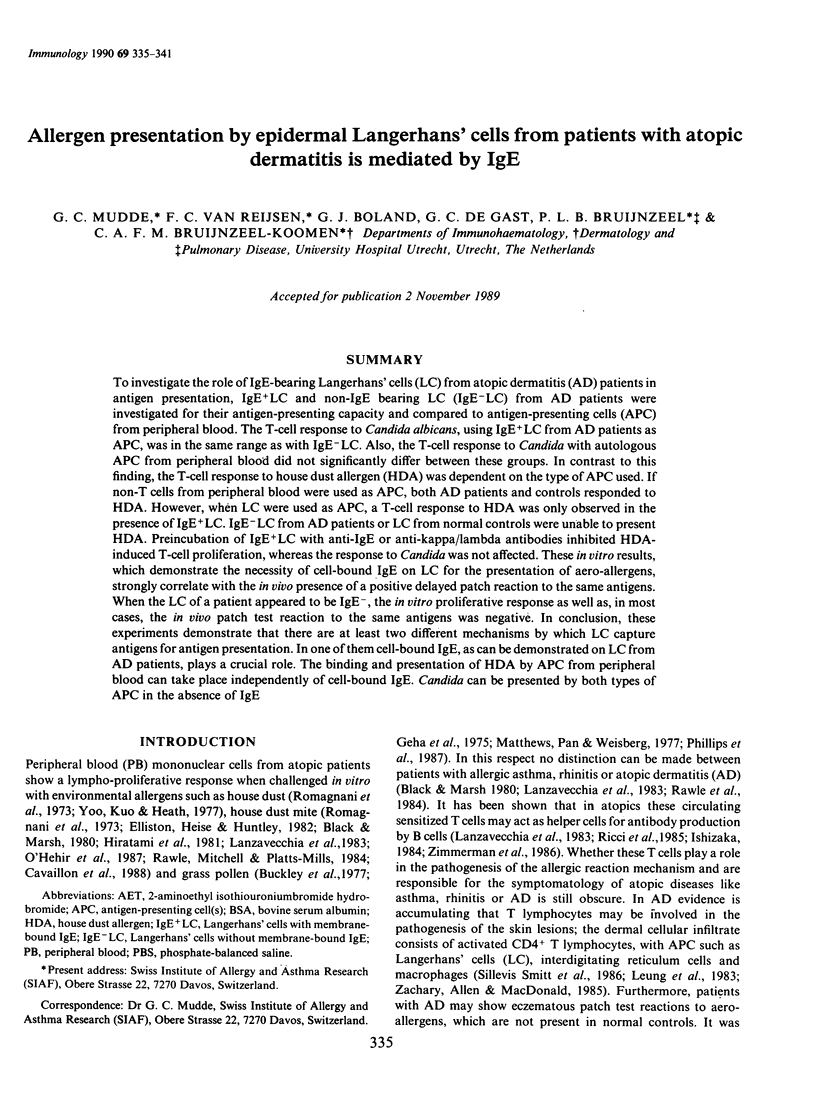
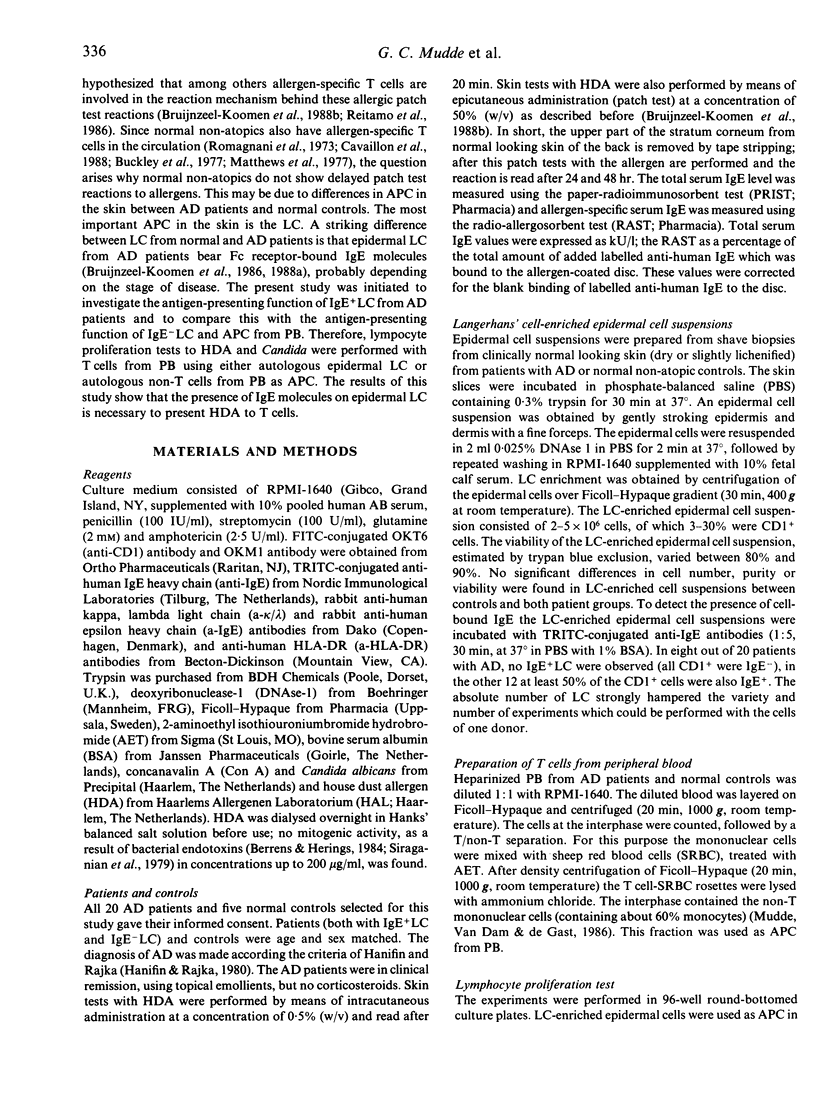

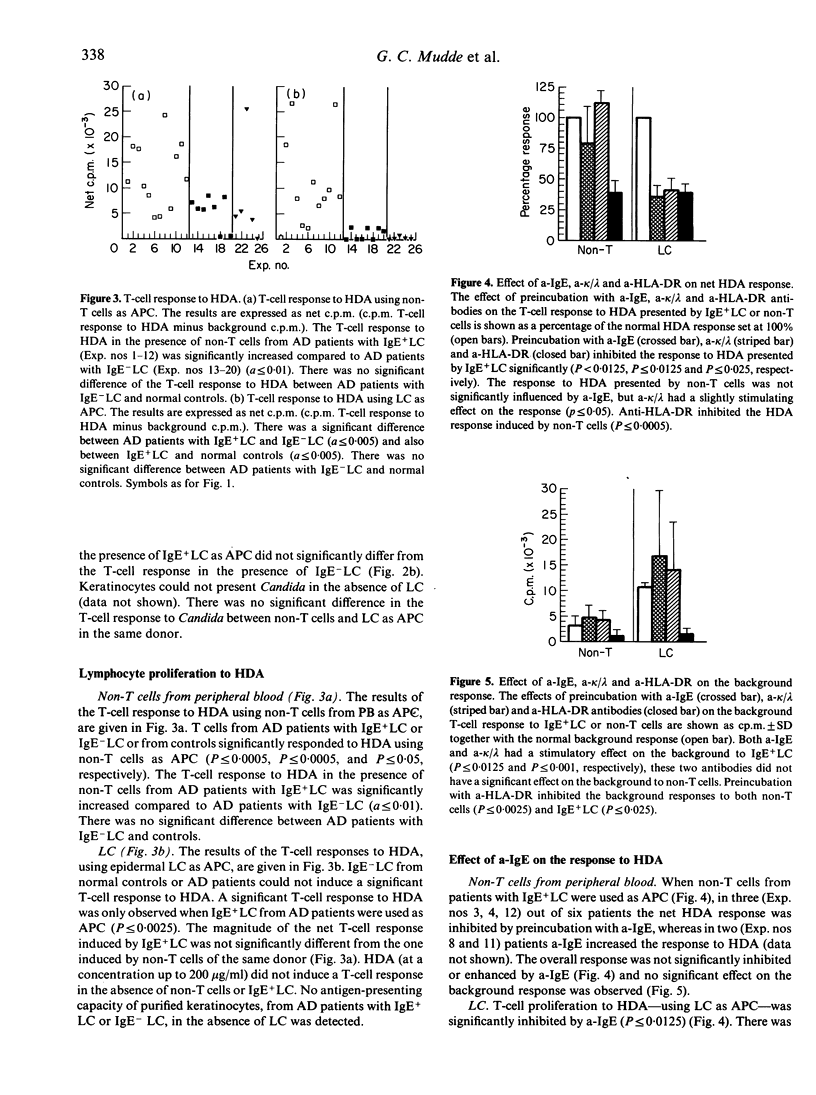
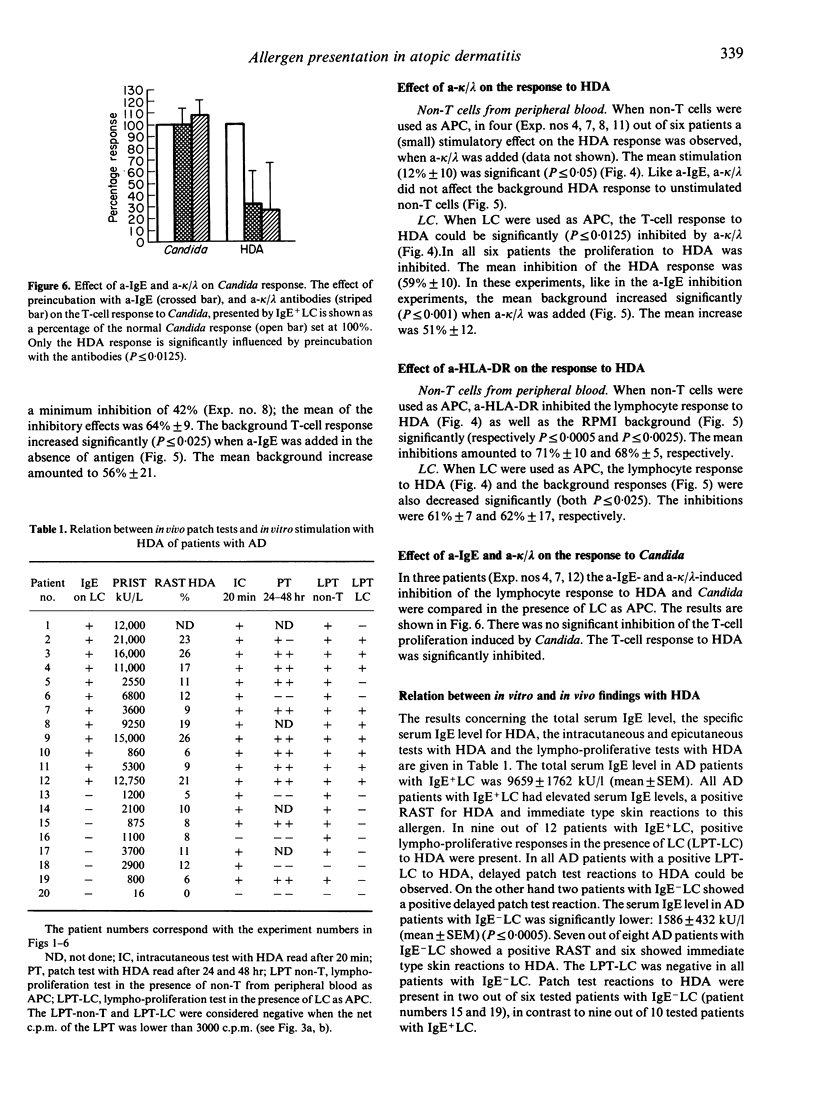
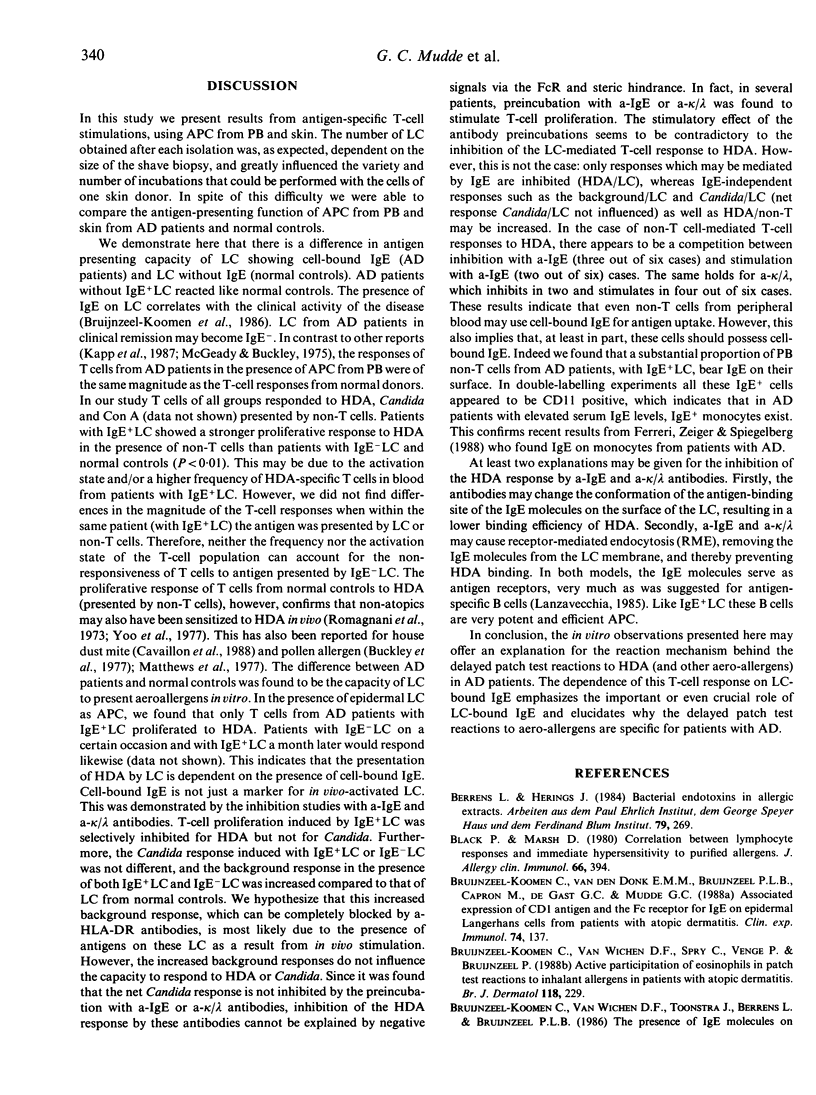
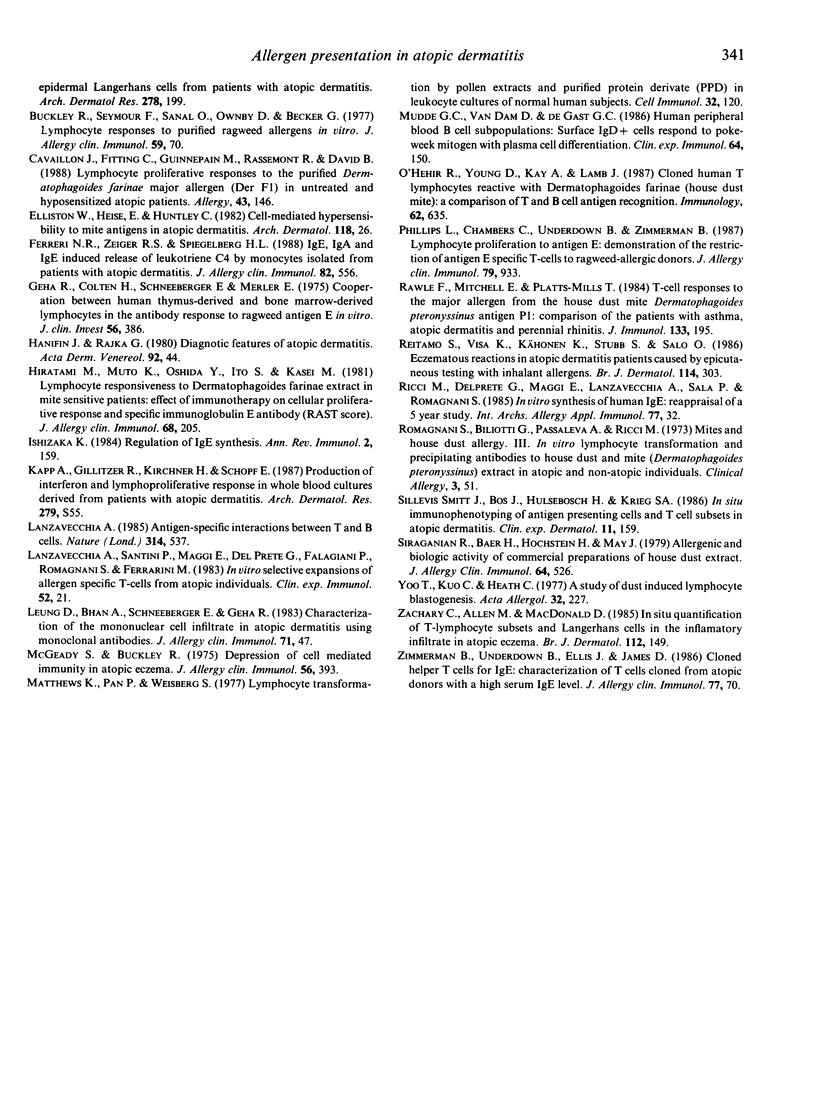
Selected References
These references are in PubMed. This may not be the complete list of references from this article.
- Black P. L., Marsh D. G. Correlation between lymphocyte responses and immediate hypersensitivity to purified allergens. J Allergy Clin Immunol. 1980 Nov;66(5):394–401. doi: 10.1016/0091-6749(80)90119-0. [DOI] [PubMed] [Google Scholar]
- Bruynzeel-Koomen C. A., Van Wichen D. F., Spry C. J., Venge P., Bruynzeel P. L. Active participation of eosinophils in patch test reactions to inhalant allergens in patients with atopic dermatitis. Br J Dermatol. 1988 Feb;118(2):229–238. doi: 10.1111/j.1365-2133.1988.tb01779.x. [DOI] [PubMed] [Google Scholar]
- Bruynzeel-Koomen C., van Wichen D. F., Toonstra J., Berrens L., Bruynzeel P. L. The presence of IgE molecules on epidermal Langerhans cells in patients with atopic dermatitis. Arch Dermatol Res. 1986;278(3):199–205. doi: 10.1007/BF00412924. [DOI] [PubMed] [Google Scholar]
- Bruynzeel-Koomen C., van der Donk E. M., Bruynzeel P. L., Capron M., de Gast G. C., Mudde G. C. Associated expression of CD1 antigen and Fc receptor for IgE on epidermal Langerhans cells from patients with atopic dermatitis. Clin Exp Immunol. 1988 Oct;74(1):137–142. [PMC free article] [PubMed] [Google Scholar]
- Buckley R. H., Seymour F., Sanal S. O., Ownby D. R., Becker W. G. Lymphocyte responses to purified ragweed allergens in vitro. I. Proliferative responses in normal, newborn, agammaglobulinemic, and atopic subjects. J Allergy Clin Immunol. 1977 Jan;59(1):70–78. doi: 10.1016/0091-6749(77)90180-4. [DOI] [PubMed] [Google Scholar]
- Cavaillon J. M., Fitting C., Guinnepain M. T., Rassemont R., David B. Lymphocyte proliferative responses to the purified Dermatophagoides farinae major allergen in untreated and hyposensitized atopic patients. Allergy. 1988 Feb;43(2):146–151. doi: 10.1111/j.1398-9995.1988.tb00409.x. [DOI] [PubMed] [Google Scholar]
- Elliston W. L., Heise E. A., Huntley C. C. Cell-mediated hypersensitivity to mite antigens in atopic dermatitis. Arch Dermatol. 1982 Jan;118(1):26–29. [PubMed] [Google Scholar]
- Ferreri N. R., Zeiger R. S., Spiegelberg H. L. IgG-, IgA-, and IgE-induced release of leukotriene C4 by monocytes isolated from patients with atopic dermatitis. J Allergy Clin Immunol. 1988 Oct;82(4):556–567. doi: 10.1016/0091-6749(88)90965-7. [DOI] [PubMed] [Google Scholar]
- Geha R. S., Colten H. R., Schneeberger E., Merler E. Cooperation between human thymus-derived and bone marrow-derived lymphocytes in the antibody response to ragweed antigen E in vitro. J Clin Invest. 1975 Aug;56(2):386–390. doi: 10.1172/JCI108103. [DOI] [PMC free article] [PubMed] [Google Scholar]
- Hiratani M., Muto K., Oshida Y., Ito S., Kasei M. Lymphocyte responsiveness to Dermatophagoides farinae extract in mite-sensitive patients: effect of immunotherapy on cellular proliferative response and specific immunoglobulin E antibody (RAST score). J Allergy Clin Immunol. 1981 Sep;68(3):205–211. doi: 10.1016/0091-6749(81)90185-8. [DOI] [PubMed] [Google Scholar]
- Ishizaka K. Regulation of IgE synthesis. Annu Rev Immunol. 1984;2:159–182. doi: 10.1146/annurev.iy.02.040184.001111. [DOI] [PubMed] [Google Scholar]
- Kapp A., Gillitzer R., Kirchner H., Schöpf E. Production of interferon and lymphoproliferative response in whole blood cultures derived from patients with atopic dermatitis. Arch Dermatol Res. 1987;279 (Suppl):S55–S58. doi: 10.1007/BF00585921. [DOI] [PubMed] [Google Scholar]
- Lanzavecchia A. Antigen-specific interaction between T and B cells. Nature. 1985 Apr 11;314(6011):537–539. doi: 10.1038/314537a0. [DOI] [PubMed] [Google Scholar]
- Lanzavecchia A., Santini P., Maggi E., Del Prete G. F., Falagiani P., Romagnani S., Ferrarini M. In vitro selective expansion of allergen specific T cells from atopic patients. Clin Exp Immunol. 1983 Apr;52(1):21–28. [PMC free article] [PubMed] [Google Scholar]
- Leung D. Y., Bhan A. K., Schneeberger E. E., Geha R. S. Characterization of the mononuclear cell infiltrate in atopic dermatitis using monoclonal antibodies. J Allergy Clin Immunol. 1983 Jan;71(1 Pt 1):47–56. doi: 10.1016/0091-6749(83)90546-8. [DOI] [PubMed] [Google Scholar]
- McGeady S. J., Buckley R. H. Depression of cell-mediated immunity in atopic eczema. J Allergy Clin Immunol. 1975 Nov;56(5):393–406. doi: 10.1016/0091-6749(75)90133-5. [DOI] [PubMed] [Google Scholar]
- Mudde G. C., van Dam D., De Gast G. C. Human peripheral blood B cell subpopulations: surface IgD+ cells respond to pokeweed mitogen with plasma cell differentiation. Clin Exp Immunol. 1986 Apr;64(1):150–157. [PMC free article] [PubMed] [Google Scholar]
- O'Hehir R. E., Young D. B., Kay A. B., Lamb J. R. Cloned human T lymphocytes reactive with Dermatophagoides farinae (house dust mite): a comparison of T- and B-cell antigen recognition. Immunology. 1987 Dec;62(4):635–640. [PMC free article] [PubMed] [Google Scholar]
- Phillips L., Chambers C., Underdown B. J., Zimmerman B. Lymphocyte proliferation to antigen E: demonstration of the restriction of antigen E-specific T cells to ragweed-allergic donors. J Allergy Clin Immunol. 1987 Jun;79(6):933–940. doi: 10.1016/0091-6749(87)90243-0. [DOI] [PubMed] [Google Scholar]
- Rawle F. C., Mitchell E. B., Platts-Mills T. A. T cell responses to the major allergen from the house dust mite Dermatophagoides pteronyssinus, Antigen P1: comparison of patients with asthma, atopic dermatitis, and perennial rhinitis. J Immunol. 1984 Jul;133(1):195–201. [PubMed] [Google Scholar]
- Reitamo S., Visa K., Kähönen K., Käyhkö K., Stubb S., Salo O. P. Eczematous reactions in atopic patients caused by epicutaneous testing with inhalant allergens. Br J Dermatol. 1986 Mar;114(3):303–309. doi: 10.1111/j.1365-2133.1986.tb02821.x. [DOI] [PubMed] [Google Scholar]
- Ricci M., Del Prete G. F., Maggi E., Lanzavecchia A., Sala P. G., Romagnani S. In vitro synthesis of human IgE: reappraisal of a 5-year study. Int Arch Allergy Appl Immunol. 1985;77(1-2):32–37. doi: 10.1159/000233749. [DOI] [PubMed] [Google Scholar]
- Sillevis Smitt J. H., Bos J. D., Hulsebosch H. J., Krieg S. R. In situ immunophenotyping of antigen presenting cells and T cell subsets in atopic dermatitis. Clin Exp Dermatol. 1986 Mar;11(2):159–168. doi: 10.1111/j.1365-2230.1986.tb00441.x. [DOI] [PubMed] [Google Scholar]
- Siraganian R. P., Baer H., Hochstein H. D., May J. C. Allergenic and biologic activity of commercial preparations of house dust extract. J Allergy Clin Immunol. 1979 Dec;64(6 Pt 1):526–533. doi: 10.1016/0091-6749(79)90063-0. [DOI] [PubMed] [Google Scholar]
- Yoo T. J., Kuo C. Y., Heath C. A study of dust-induced lymphocyte blastogenesis. Acta Allergol. 1977 Aug;32(4):227–235. doi: 10.1111/j.1398-9995.1977.tb01355.x. [DOI] [PubMed] [Google Scholar]
- Zachary C. B., Allen M. H., MacDonald D. M. In situ quantification of T-lymphocyte subsets and Langerhans cells in the inflammatory infiltrate of atopic eczema. Br J Dermatol. 1985 Feb;112(2):149–156. doi: 10.1111/j.1365-2133.1985.tb00078.x. [DOI] [PubMed] [Google Scholar]
- Zimmerman B., Underdown B. J., Ellis J., James O. Cloned helper T cell for IgE: characterization of T cells cloned from an atopic donor with a high serum IgE. J Allergy Clin Immunol. 1986 Jan;77(1 Pt 1):70–79. doi: 10.1016/0091-6749(86)90326-x. [DOI] [PubMed] [Google Scholar]


